Canidae
| Canids[1] Temporal range: Late Eocene – Recent
| |
|---|---|
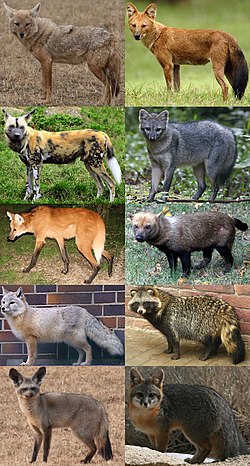
| |
| Major extant canid genera left-to-right, top-to-bottom: Canis, Cuon, Lycaon, Cerdocyon, Chrysocyon, Speothos, Vulpes, Nyctereutes, Otocyon and Urocyon | |
| Scientific classification | |
| Kingdom: | Animalia |
| Phylum: | Chordata |
| Class: | Mammalia |
| Order: | Carnivora |
| Suborder: | Caniformia |
| Family: | Canidae G. Fischer de Waldheim, 1817 |
| Genera and species | |
|
See text | |
The biological family Canidae /ˈkæn[invalid input: 'ɨ']diː/ [2] is a lineage of carnivorans that includes dogs, wolves, foxes, jackals, and many other extant and extinct dog-like mammals. A member of this family is called a canid (/ˈkæn[invalid input: 'ɨ']d/, /ˈkeɪn[invalid input: 'ɨ']d/).[3] The Canidae family is divided into two tribes: the Canini (dogs, wolves and jackals) and the Vulpini (foxes).
Canids have a long evolutionary history. In the Eocene, about 50 million years ago, the carnivorans split into two lineages, the caniforms (dog-like) and feliforms (cat-like). By the Oligocene, some ten million years later, the first proper canids had appeared and the family had split into three subfamilies, Hesperocyoninae, Borophaginae, and Caninae. Only the last of these has survived until the present day.
Canids are found on all continents except Antarctica and vary in size from the 2-m-long (6 ft 7 in) gray wolf to the 24-cm-long (9.4 in) fennec fox. The body forms of canids are similar, typically having long muzzles, upright ears, teeth adapted for cracking bones and slicing flesh, long legs, and bushy tails. They are mostly social animals, living together in family units or small groups and behaving cooperatively. Typically, only the dominant pair in a group breeds, and a litter of young is reared annually in an underground den. Canids communicate by scent signals and by vocalizations. One canid, the domestic dog, long ago entered into a partnership with humans and today remains one of the most widely kept domestic animals.
Classification and relationship
[edit]Within the Canidae, the results of allozyme and chromosome analyses suggest several phylogenetic divisions:
- The wolf-like canids, (genus Canis, Cuon and Lycaon) including the dog, gray wolf (Canis lupus), red wolf (Canis rufus), eastern wolf (Canis lycaon), coyote (Canis latrans), golden jackal (Canis aureus), Ethiopian wolf (Canis simensis), black-backed jackal (Canis mesomelas), side-striped jackal (Canis adustus), dhole (Cuon alpinus), and African wild dog (Lycaon pictus).[4]
- The fox-like canids, which include the kit fox ("Vulpes aelox"), red fox (Vulpes vulpes), Cape fox (Vulpes chama), Arctic fox (Alopex lagopus), and fennec fox (Fennecus zerda).[4]
- The South American canids, including the bush dog (Speothos venaticus), hoary fox (Lycalopex uetulus), crab-eating fox (Cerdocyon thous) and maned wolf.[4]
- monotypic taxon, including the bat-eared fox (Otocyon megalotis), gray fox (Urocyon cinereoargenteus), and raccoon dog (Nycteruetes procyonoides).[4]
| ||||||||||||||||||
Recent DNA analysis shows that there are three monophyletic clades. Two of these, the South American canine group, which includes a number of "foxes", and the wolf group, together form the tribe Canini. The third clade is the "true fox" group, tribe Vulpini.[5] Molecular data imply a North American origin of living Canidae some ten million years ago and an African origin of wolf-like canines (Canis, Cuon, and Lycaon), with the jackals being the most basal of this group. The South American clade is rooted by the maned wolf and bush dog, and the fox-like canids by the fennec fox and Blanford's fox. The grey fox and island fox are basal to the other clades, however this topological difference is not strongly supported.[6]
Currently, the domestic dog is listed as a subspecies of Canis lupus, C. l. familiaris, and the dingo (also considered a domestic dog) as C. l. dingo, provisionally a separate subspecies from C. l. familiaris; the red wolf, eastern Canadian wolf, and Indian wolf are recognized as subspecies.[1] Though often listed as Canis familiaris, the Smithsonian Institution and the American Society of Mammalogists more precisely list the domestic dog as a subspecies of C. lupus.[7] The red wolf, eastern Canadian wolf, and Indian wolf may or may not be separate species; in the past, the dingo has been variously classified as Canis dingo, Canis familiaris dingo and Canis lupus familiaris dingo. [7]
The gray wolf can disperse widely, with some animals moving over 1,000 km (625 miles) from their place of birth, but analysis of mtDNA does not support the existence of multiple subspecies; virtually identical genotypes were identified from as far apart as Alaska and southern Canada. Nor could significant genetic differences be detected between widely separated populations of coyotes.[8]
Evolution
[edit]The Canidae includes a diverse group of some 34 species ranging in size from the maned wolf with its long limbs to the short-legged bush dog. Modern canids inhabit forests, tundra, savannahs and deserts throughout tropical and temperate parts of the world. The evolutionary relationships between the species have been studied in the past using morphological approaches but more recently, molecular studies have enabled the investigation of phylogenetic relationships. In some species, genetic divergence has been suppressed by the high level of gene flow between different populations and where the species have hybridized, large hybrid zones exist.[8]
Eocene epoch
[edit]Carnivorans evolved from miacoids about 55 million years ago (Mya) during the late Paleocene.[9] Some five million years later, the carnivorans split into two main divisions: caniforms (dog-like) and feliforms (cat-like). By 40 Mya, the first member of the dog family proper had arisen. Called Prohesperocyon wilsoni, its fossilized remains have been found in what is now the southwestern part of Texas. The chief features which identify it as a canid include the loss of the upper third molar (part of a trend toward a more shearing bite), and the structure of the middle ear which has an enlarged bulla (the hollow bony structure protecting the delicate parts of the ear). Prohesperocyon probably had slightly longer limbs than its predecessors, and also had parallel and closely touching toes which differ markedly from the splayed arrangements of the digits in bears.[10]
The canid family soon subdivided into three subfamilies, each of which diverged during the Eocene: Hesperocyoninae (about 39.74-15 Mya), Borophaginae (about 34-2 Mya), and Caninae (about 34-0 Mya). Caninae is the only surviving subfamily and all present-day canids including wolves, foxes, coyotes, jackals, and domestic dogs belong to it. Members of each subfamily showed an increase in body mass with time, and some exhibited specialised hypercarnivorous diets that made them prone to extinction.[11]: Fig. 1
Template:Canidae graphical timeline
Oligocene epoch
[edit]By the Oligocene, all three subfamilies of canids (Hesperocyoninae, Borophaginae, and Caninae) had appeared in the fossil records of North America. The earliest and most primitive branch of the Canidae was the Hesperocyoninae lineage, which included the coyote-sized Mesocyon of the Oligocene (38-24 Mya). These early canids probably evolved for the fast pursuit of prey in a grassland habitat; they resembled modern civets in appearance. Hesperocyonines eventually became extinct in the middle Miocene. One of the early members of the Hesperocyonines, the genus Hesperocyon, gave rise to Archaeocyon and Leptocyon. These branches led to the borophagine and canine radiations.[12]
Miocene epoch
[edit]Around 9–10 Mya during the Late Miocene, Canis, Urocyon, and Vulpes genera expanded from southwestern North America, where the canine radiation began. The success of these canines was related to the development of lower carnassials that were capable of both mastication and shearing.[12] Around 8 Mya, the Beringian land bridge allowed members of the genus Eucyon a means to enter Asia and they continued on to colonise Europe.[13]
Pliocene epoch
[edit]During the Pliocene, around 4–5 Mya, Canis lepophagus appeared in North America. This was small and sometimes coyote-like. Others were wolf-like in characteristics.Canis latrans (the coyote) is theorized to have descended from Canis lepophagus.[14]
The formation of the Isthmus of Panama, about 3 Mya, joined South America to North America, allowing canids to invade South America, where they diversified. However the most recent common ancestor of the South American canids lived in North America some 4 Mya and the likelihood is that there were more than one incursion across the new land bridge. One of the resulting lineages consisted of the gray fox (Urocyon cinereoargentus) and the now extinct dire wolf (Canis dirus). The other lineage consisted of the so-called South American endemic species, the maned wolf (Chrysocyon brachyurus), the short-eared dog (Atelocynus microtis), the bush dog (Speothos venaticus), the crab-eating fox (Cerdocyon thous) and the South American foxes (Lycalopex spp.). The monophyly of this group has been established by molecular means.[13]
Pleistocene epoch
[edit]During the Pleistocene, the North American wolf line appeared, with Canis edwardii, clearly identifiable as a wolf, and Canis rufus appeared, possibly a direct descendent of Canis edwardii. Around 0.8 Mya, Canis ambrusteri emerged in North America. A large wolf, it was found all over North and Central America, and was eventually supplanted by its descendant, the dire wolf, which then spread into South America during the late Pleistocene.[15]
By 0.3 Mya, a number of subspecies of the gray wolf (Canis lupus) had developed and had spread throughout Europe and northern Asia.[16] The gray wolf colonized North America during the late Rancholabrean era across the Bering land bridge, there being at least three separate invasions, with each one consisting of one or more different Eurasian gray wolf clades.[17] MtDNA studies have shown that there are at least four extant C. lupus lineages.[18] The dire wolf shared its habitat with the gray wolf but became extinct in a large-scale extinction event that occurred around 11,500 years ago. It may have been more of a scavenger than a hunter; its molars appear to be adapted for crushing bones and it may have died out as a result of the extinction of the large herbivorous animals on whose carcases it relied.[15]
Characteristics
[edit]Wild canids are found on every continent except Antarctica, and inhabit a wide range of different habitats, including deserts, mountains, forests, and grasslands. They vary in size from the fennec fox, which may be as little as 24 cm (9.4 in) in length and weigh 0.6 kg (1.3 lb),[19] to the gray wolf, which may be up to 160 cm (5.2 ft) long, and can weigh up to 39 kg (86 lb).[20] Only a few species are arboreal – the North American gray fox, the closely related Channel Island fox,[21] and the raccoon dog habitually climb trees.[22][23][24]
All canids have a similar basic form, as exemplified by the grey wolf, although the relative length of muzzle, limbs, ears and tail vary considerably between species. With the exceptions of the bush dog, raccoon dog, and some domestic breeds of Canis lupus, canids have relatively long legs and lithe bodies, adapted for chasing prey. The tails are bushy and the length and quality of the pelage varies with the season. The muzzle portion of the skull is much more elongated than that of the cat family. The zygomatic arches are wide, there is a transverse lambdoidal ridge at the rear of the cranium and in some species, a sagittal crest running from front to back. The bony orbits around the eye never form a complete ring and the auditory bullae are smooth and rounded.[25]
All canids are digitigrade, meaning they walk on their toes. The tip of the nose is always naked, as are the cushioned pads on the soles of the feet. These latter consist of a single pad behind the tip of each toe and a more-or-less three-lobed central pad under the roots of the digits. Hairs grow between the pads and in the Arctic fox, the sole of the foot is densely covered with hair at some times of year. With the exception of the four-toed African hunting dog (Lycaon pictus), there are five toes on the forefeet but the pollex (thumb) is reduced and does not reach the ground. On the hind feet, there are four toes, but in some domestic dogs, a fifth vestigial toe, known as a dewclaw, is sometimes present but has no anatomical connection to the rest of the foot. The slightly curved nails are non-retractile and more or less blunt.[25]
The penis in male canids is supported by a bone called the baculum. It also contains a structure at the base called the bulbus glandis which helps to create a copulatory tie during mating, locking the animals together for up to an hour.[26] Young canids are born blind, with their eyes opening a few weeks after birth.[27] All living canids (Caninae) have a ligament analogous to the nuchal ligament of ungulates used to maintain the posture of the head and neck with little active muscle exertion; this ligament allows them to conserve energy while running long distances following scent trails with their nose to the ground.[28] However, based on skeletal details of the neck, at least some Borophaginae (such as Aelurodon) are believed to have lacked this ligament.[28]
Dentition
[edit]Most canids have 42 teeth, with a dental formula of: Template:DentalFormula. The bush dog has only one upper molar with two below, the dhole has two above and two below, and the bat-eared fox has three or four upper molars and four lower ones.[25] As in other members of Carnivora, the upper fourth premolar and lower first molar are adapted as carnassial teeth for slicing flesh, although the bat-eared fox differs in this respect, being largely insectivorous. The molar teeth are strong in most species, allowing the animals to crack open bone to reach the marrow. The deciduous, or baby teeth, formula in canids is Template:DentalFormula, molars being completely absent.[25]
Social behavior
[edit]
Template:See also Almost all canids are social animals and live together in groups. In general, they are territorial or have a home range and sleep in the open, using their dens only for breeding and sometimes in bad weather.[29] In most foxes, and in many of the true dogs, a male and female pair work together to hunt and to raise their young. Gray wolves and some of the other larger canids live in larger groups called packs. African wild dogs have packs which may consist of twenty to forty animals, and packs of fewer than about seven individuals may be incapable of successful reproduction.[30] Hunting in packs has the advantage that larger prey items can be tackled. Some species form packs or live in small family groups depending on the circumstances, including the type of available food. In most species, some individuals live on their own. Within a canid pack, there is a system of dominance so that the strongest, most experienced animals lead the pack. In most cases, the dominant male and female are the only pack members to breed.[31]
Canids communicate with each other by scent signals, by visual clues and gestures, and by vocalizations such as growls, barks, and howls. In most cases, groups have a home territory from which they drive out other conspecifics. The territory is marked by leaving urine scent marks, which warn trespassing individuals.[32] Social behaviour is also mediated by secretions from glands on the upper surface of the tail near its root and from the anal glands.[31]
Reproduction
[edit]
Canids as a group exhibit several reproductive traits that are uncommon among mammals as a whole. They are typically monogamous, provide paternal care to their offspring, have reproductive cycles with lengthy proestral and dioestral phases and have a copulatory tie during mating. They also retain adult offspring in the social group, suppressing the ability of these to breed while making use of the alloparental care they can provide to help raise the next generation of offspring.[33]
During the proestral period, increased levels of oestradiol make the female attractive to the male. There is a rise in progesterone during the oestral phase and the female is now receptive. Following this, the level of oestradiol fluctuates and there is a lengthy dioestrous phase during which the female is pregnant. Pseudo-pregnancy frequently occurs in canids that have ovulated but failed to conceive. A period of anoestrus follows pregnancy or pseudo-pregnancy, there being only one oestral period during each breeding season. Small and medium-sized canids mostly have a gestation period of fifty to sixty days while larger species average sixty to sixty-five days. The time of year in which the breeding season occurs is related to the length of day, as has been demonstrated in the case of several species that have been translocated across the equator to the other hemisphere and experiences a six-month shift of phase. Domestic dogs and certain small canids in captivity may come into oestrus more frequently, perhaps because the photoperiod stimulus breaks down under conditions of artificial lighting.[33]
The size of a litter varies,with from one to sixteen or more pups being born. The young are born small, blind and helpless and require a long period of parental care. They are kept in a den, most often dug into the ground, for warmth and protection.[25] When the young begin eating solid food, both parents, and often other pack members, bring food back for them from the hunt. This is most often vomited up from the adult's stomach. Where such pack involvement in the feeding of the litter occurs, the breeding success rate is higher than is the case where females split from the group and rear their pups in isolation.[34] Young canids may take a year to mature and learn the skills they need to survive.[35] In some species, such as the African wild dog, male offspring usually remain in the natal pack, while females disperse as a group, and join another small group of the opposite sex to form a new pack.[36]
Canids and humans
[edit]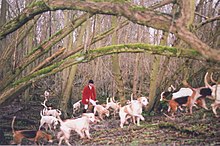
One canid, the domestic dog, entered into a partnership with humans a long time ago. This partnership is documented as far back as 26,000 years ago, when the footprints of a young boy aged about eight to ten was found in Chauvet Cave in southern France, walking alongside what was identified as a large dog or wolf.[37] The earliest recorded fossil of a dog was found to be around 36,000 years ago in Goyet Cave in Belgium.[38] Even earlier, wolves were found fossilized in the same locations as humans at sites that date back 300,000 years, showing how far back humans and wolves had interactions with one another.[39] The fact that wolves are pack animals with cooperative social structures may have been the reason that the relationship developed. Humans benefited from the canid's loyalty, cooperation, teamwork, alertness and tracking abilities while the wolf may have benefited from the use of weapons to tackle larger prey and the sharing of food. Humans and dogs may have evolved together.[40] The bond between humans and dogs can be seen in the burial of dogs with their owners as early as 11,000 years ago in the Americas and 8,500 years ago in Europe.[39]
Among canids, only the gray wolf has widely been known to prey on humans.[41] Nonetheless, at least two records have coyotes killing humans,[42] and two have golden jackals killing children.[43] Human beings have trapped and hunted some canid species for their fur and, especially the gray wolf, coyote and the red fox, for sport.[44] Canids such as the dhole are now endangered in the wild because of persecution, habitat loss, a depletion of ungulate prey species and transmission of diseases from domestic dogs.[45]
Species and taxonomy
[edit]
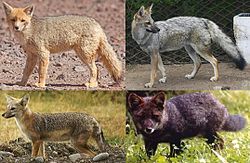


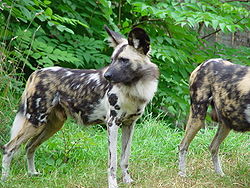

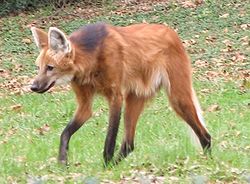

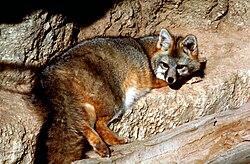

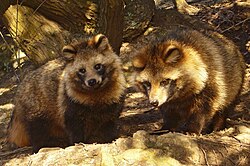
FAMILY CANIDAE (Extant and recently extinct species)
Subfamily Caninae
[edit]- True dogs – Tribe Canini
- Genus Canis
- Gray wolf, Canis lupus 2.723 Mya to present)
- Domestic dog, Canis lupus familiaris
- Dingo, most often classified as Canis lupus dingo (sometimes considered a separate taxon)
- many other subspecies
- Coyote, Canis latrans (also called prairie wolf)
- Golden jackal, Canis aureus
- Ethiopian wolf, Canis simensis (also called Abyssinian wolf, simien fox and simien jackal)
- Side-striped jackal, Canis adustus
- Black-backed jackal, Canis mesomelas
- Gray wolf, Canis lupus 2.723 Mya to present)
- Genus Cuon
- Dhole, Cuon alpinus or Canis alpinus (also called Asian wild dog)
- Genus Lycaon
- African wild dog, Lycaon pictus (also called African hunting dog)
- Genus Atelocynus
- Short-eared dog, Atelocynus microtis
- Genus Cerdocyon
- Crab-eating fox, Cerdocyon thous
- Genus Dusicyon †
- Falklands wolf, Dusicyon australis †
- Genus Lycalopex (Pseudalopex)
- Culpeo, Lycalopex culpaeus
- Darwin's fox, Lycalopex fulvipes
- South American gray fox, Lycalopex griseus
- Pampas fox, Lycalopex gymnocercus
- Sechura fox, Lycalopex sechurae
- Hoary fox, Lycalopex vetulus
- Genus Chrysocyon
- Maned wolf, Chrysocyon brachyurus
- Genus Speothos
- Bush dog, Speothos venaticus
- Genus Canis
- True foxes – Tribe Vulpini
- Genus Vulpes
- Arctic fox, Vulpes lagopus
- Red fox, Vulpes vulpes (1 Mya to present), including a domesticated silver fox
- Swift fox, Vulpes velox
- Kit fox, Vulpes macrotis
- Corsac fox, Vulpes corsac
- Cape fox, Vulpes chama
- Pale fox, Vulpes pallida
- Bengal fox, Vulpes bengalensis
- Tibetan sand fox, Vulpes ferrilata
- Blanford's fox, Vulpes cana
- Rüppell's fox, Vulpes rueppelli
- Fennec fox, Vulpes zerda
- Genus Urocyon (2 Mya to present)
- Gray fox, Urocyon cinereoargenteus
- Island fox, Urocyon littoralis
- Cozumel fox, Urocyon sp.
- Genus Vulpes
- Basal Caninae
- Genus Otocyon (probably a vulpine close to Urocyon)
- Bat-eared fox, Otocyon megalotis
- Genus Nyctereutes
- Raccoon dog, Nyctereutes procyonoides
- Genus Otocyon (probably a vulpine close to Urocyon)

Prehistoric Canidae
[edit]Except where otherwise stated, the following classification is based on a 1994 paper by Xiaoming Wang, curator of terrestrial mammals at the Natural History Museum of Los Angeles County on the systematics of the subfamily Hesperocyoninae,[46] a 1999 paper by Wang, together with the zoologists Richard H. Tedford and Beryl E. Taylor on the subfamily Borophaginae,[47] and a 2009 paper by Tedford, Wang and Taylor on the North American fossil Caninae.[48]
Caninae
[edit]- Tribe Canini[48]
- Genus Canis
- Canis adoxus †
- Canis ameghinoi †
- Canis apolloniensis (Template:Mya) †
- Canis armbrusteri (Template:Mya) †
- Canis arnensis (3.4 Mya, †)
- Canis cautleyi †
- Canis cedazoensis (Template:Mya) †
- Canis dirus (Dire wolf), (Template:Mya) †
- Canis donnezani (4.0–3.1 Ma †, probably ancestor of wolves)
- Canis edwardii (Template:Mya) †, first species of wolf in North America)
- Canis (Eucyon) cipio (8.2 Mya †, probably first species of Canis genus)
- Canis etruscus (3.4 Mya †)
- Canis ferox (Template:Mya) †
- Canis gezi †
- Canis lepophagus (Template:Mya)†
- Canis michauxi †
- Canis mosbachensis (0.787 Mya †)
- Canis nehringi †
- Genus Cynotherium †
- Sardinian dhole, Cynotherium sardous †
- Genus Theriodictis (Template:Mya)†
- Genus Protocyon †
- Genus Dusicyon †
- Dusicyon avus †
- Genus Cerdocyon
- Cerdocyon avius †
- Cerdocyon ensenadensis †
- Genus Speothos
- Genus Nurocyon †
- Nurocyon chonokhariensis †
- Genus Xenocyon †
- Xenocyon falconeri (2.6 Mya †)
- Xenocyon lycaonoides (Template:Mya) †
- Genus Canis
- Tribe Vulpini
- Basal Caninae
- Genus Nyctereutes (7.1 Mya to present)
- First Caninae
Borophaginae
[edit]† (Mya = million years ago) (million years = in existence)
- Genus Archaeocyon (Template:Mya) †
- Archaeocyon falkenbachi (Template:Mya) †
- Archaeocyon leptodus (Template:Mya) †
- Archaeocyon pavidus (Template:Mya) †
- Genus Otarocyon (Template:Mya) †
- Otarocyon cooki (Template:Mya) †
- Otarocyon macdonaldi (Template:Mya) †
- Genus Oxetocyon (Template:Mya) †
- Oxetocyon cuspidatus (Template:Mya) †
- Genus Rhizocyon (30 Mya)
- Rhizocyon oregonensis (30 Mya)
- Genus Archaeocyon (Template:Mya) †
- Tribe Phlaocyonini (Template:Mya) †
- Genus Cynarctoides (Template:Mya) †
- Genus Phlaocyon (30–19 Mya)
- Phlaocyon achoros
- Phlaocyon annectens (22 Mya)
- Phlaocyon latidens (30 Mya)
- Phlaocyon leucosteus (22 Mya)
- Phlaocyon mariae
- Phlaocyon marslandensis (19 Mya)
- Phlaocyon minor (30 Mya)
- Phlaocyon multicuspus
- Phlaocyon taylori[49]
- Phlaocyon yakolai (19 Mya)
- Tribe Borophagini (Template:Mya) †
- Genus Cormocyon (Template:Mya) †
- Cormocyon copei (Template:Mya) †
- Cormocyon haydeni (Template:Mya) †
- Genus Desmocyon (Template:Mya) †
- Desmocyon matthewi (Template:Mya) †
- Desmocyon thompsoni †
- Genus Metatomarctus (Template:Mya) †
- Metatomarctus canavus (Template:Mya) †
- Metatomarctus sp. A (16 Mya)
- Metatomarctus sp. B (16 Mya)
- Genus Eulopocyon (18–16 Mya)
- Eulopocyon brachygnathus (16 Mya)
- Eulopocyon spissidens (18 Mya)
- Genus Psalidocyon (16 Mya)
- Psalidocyon marianae (16 Mya)
- Genus Microtomarctus (Template:Mya) †
- Microtomarctus conferta (Template:Mya) †
- Genus Protomarctus (18 Mya)
- Protomarctus optatus (18 Mya)
- Genus Tephrocyon (16 Mya)
- Tephrocyon rurestris (16 Mya)
- Subtribe Cynarctina †
- Genus Paracynarctus (Template:Mya) †
- Paracynarctus kelloggi (Template:Mya) †
- Paracynarctus sinclairi (Template:Mya) †
- Genus Cynarctus (Template:Mya) †
- Cynarctus crucidens (Template:Mya) †
- Cynarctus galushai (Template:Mya) †
- Cynarctus marylandica (Template:Mya) †
- Cynarctus saxatilis (Template:Mya) †
- Cynarctus voorhiesi (Template:Mya) †
- Genus Paracynarctus (Template:Mya) †
- Subtribe Aelurodontina (Template:Mya) †
- Genus Tomarctus (Template:Mya) †
- Tomarctus brevirostris (Template:Mya) †
- Tomarctus hippophaga (Template:Mya) †
- Genus Aelurodon (Template:Mya) †
- Aelurodon asthenostylus (Template:Mya) †
- Aelurodon ferox (Template:Mya) †
- Aelurodon mcgrewi (Template:Mya) †
- Aelurodon montanensis (Template:Mya) †[50]
- Aelurodon stirtoni (Template:Mya) †
- Aelurodon taxoides (Template:Mya) †
- Genus Tomarctus (Template:Mya) †
- Subtribe Borophagina (Template:Mya) †
- Genus Paratomarctus (Template:Mya) †
- Paratomarctus euthos (13 Mya)
- Paratomarctus temerarius (16 Mya)
- Genus Carpocyon (Template:Mya) †
- Carpocyon compressus (Template:Mya) †
- Carpocyon limosus (Template:Mya) †
- Carpocyon robustus (Template:Mya) †
- Carpocyon webbi (Template:Mya) †
- Genus Protepicyon (16 Mya)
- Protepicyon raki (16 Mya)
- Genus Epicyon (Template:Mya) †
- Epicyon aelurodontoides (Template:Mya) †
- Epicyon haydeni (Template:Mya) †
- Epicyon saevus (Template:Mya) †
- Genus Borophagus (Template:Mya) †
- Genus Paratomarctus (Template:Mya) †
- Genus Cormocyon (Template:Mya) †
Hesperocyoninae
[edit]† (Mya = million years ago)
- Genus Cynodesmus (32–29 Mya)
- Cynodesmus martini (29 Mya)
- Cynodesmus thooides (32 Mya)
- ?Genus Caedocyon
- Caedocyon tedfordi
- Genus Ectopocynus (32–19 Mya)
- Ectopocynus antiquus (32 Ma)
- Ectopocynus intermedius (29 Mya)
- Ectopocynus siplicidens (19 Mya)
- Genus Enhydrocyon (29–25 Mya)
- Enhydrocyon basilatus (25 Mya)
- Enhydrocyon crassidens (25 Mya)
- Enhydrocyon pahinsintewkpa (29 Mya)
- Enhydrocyon stenocephalus (29 Mya)
- Genus Hesperocyon (39.74–34 Mya)
- Hesperocyon coloradensis
- Hesperocyon gregarius (37 Mya)
- Genus Mesocyon (34–29 Mya)
- Mesocyon brachyops (29 Mya)
- Mesocyon coryphaeus (29 Mya)
- Mesocyn temnodon
- Genus Osbornodon (32–18 Mya)
- Osbornodon brachypus
- Osbornodon fricki (18 Mya)
- Osbornodon iamonensis (21 Mya)
- Osbornodon renjiei (33 Mya)
- Osbornodon scitulus[51]
- Osbornodon sesnoni (32 Mya)
- Osbornodon wangi[49]
- Genus Paraenhydrocyon (30–25 Mya)
- Paraenhydrocyon josephi (30 Mya)
- Paraenhydrocyon robustus (25 Mya)
- Genus Philotrox (29 Mya)
- Philotrox condoni (29 Mya)
- Genus Prohesperocyon (36 Mya)
- Prohesperocyon wilsoni (36 Mya)
- Genus Sunkahetanka (29 Mya)
- Sunkahetanka geringensis (29 Mya)
- Genus Cynodesmus (32–29 Mya)
References
[edit]- ^ Jump up to: a b Template:MSW3 Wozencraft
- ^ Canidae. Dictionary.com. The American Heritage Stedman's Medical Dictionary. Houghton Mifflin Company. http://dictionary.reference.com/browse/Canidae (accessed: February 16, 2009).
- ^ Canid Merriam-Webster.com. Canid definition Merriam-Webster. Retrieved 2014-05-27
- ^ Jump up to: a b c d Wayne, Robert K. (June 1993). "Molecular evolution of the dog family". Trends in Genetics. 9 (6): 218–224. PMID 8337763.
- ^ Jensen, Per (2007). The Behavioural Biology of Dogs. CABI. pp. 11–13. ISBN 978-1-84593-188-9.
- ^ doi: 10.1038/nature04338
This citation will be automatically completed in the next few minutes. You can jump the queue or expand by hand - ^ Jump up to: a b Lua error in package.lua at line 80: module 'Module:Citation/CS1/Suggestions' not found.
- ^ Jump up to: a b Wayne, Robert K. "Molecular evolution of the dog family". Retrieved 2014-05-27.
- ^ "The Paleobiology Database". Paleodb.org. Retrieved 2012-06-12.
- ^ Wang, Xiaoming (2008). "How Dogs Came to Run the World". Natural History Magazine. July/August. Retrieved 2014-05-24.
- ^ doi:10.1126/science.1102417
This citation will be automatically completed in the next few minutes. You can jump the queue or expand by hand - ^ Jump up to: a b Martin, L.D. 1989. Fossil history of the terrestrial carnivora. Pages 536–568 in J.L. Gittleman, editor. Carnivore Behavior, Ecology, and Evolution, Vol. 1. Comstock Publishing Associates: Ithaca.
- ^ Jump up to: a b Perini, F. A.; Russo, C. A. M.; Schrago, C. G. (2010). "The evolution of South American endemic canids: a history of rapid diversification and morphological parallelism". Journal of Evolutionary Biology. 23 (2): 311–322. doi:10.1111/j.1420-9101.2009.01901.x. PMID 20002250.
{{cite journal}}: CS1 maint: multiple names: authors list (link) - ^ Nowak, R.M. 1979. North American Quaternary Canis. Monograph of the Museum of Natural History, University of Kansas 6:1 – 154.
- ^ Jump up to: a b Larson, Robert. "Wolves, coyotes and dogs (Genus Canis)". The Midwestern United States 16,000 years ago. Illinois State Museum. Retrieved 2014-06-07.
- ^ Nowak, R. 1992. Wolves: The great travelers of evolution. International Wolf 2(4):3 – 7.
- ^ "An account of the taxonomy of North American wolves from morphological and genetic analyses". North American Fauna. 77: 1–67. 2012. doi:10.3996/nafa.77.0001.
{{cite journal}}: Cite uses deprecated parameter|authors=(help) - ^ Gaubert, P.; Bloch, C.; Benyacoub, S.; Abdelhamid, A.; Pagani, P.; et al. (2012). "Reviving the African Wolf Canis lupus lupaster in North and West Africa: A Mitochondrial Lineage Ranging More than 6,000 km Wide". PLoS ONE. 7 (8): e42740. doi:10.1371/journal.pone.0042740. PMC 3416759. PMID 22900047.
{{cite journal}}: Explicit use of et al. in:|author=(help)CS1 maint: multiple names: authors list (link) CS1 maint: unflagged free DOI (link) - ^ Marc Tyler Nobleman (2007). Foxes. Marshall Cavendish. p. 35. ISBN 978-0-7614-2237-2.
- ^ Heptner, V. G.; Naumov, N. P. (1998), Mammals of the Soviet Union Vol.II Part 1a, Sirenia and Carnivora (Sea cows; Wolves and Bears), Science Publishers, Inc. USA., pp. 166–176, ISBN 1-886106-81-9
- ^ "ADW: Urocyon littoralis: Information". Animaldiversity.ummz.umich.edu. 1999-11-28. Retrieved 2012-06-12.
- ^ Kauhala, K.; Saeki, M. (2004). Raccoon Dog«. Canid Species Accounts. IUCN/SSC Canid Specialist Group. Pridobljeno 15.4.2009.
- ^ Ikeda, Hiroshi (August 1986). "Old dogs, new tricks: Asia's raccoon dog, a venerable member of the canid family is pushing into new frontiers". Natural History. 95 (8): p40, 44.
{{cite journal}}:|pages=has extra text (help) - ^ Raccoon dog – Nyctereutes procyonoides. WAZA – World Association of Zoos and Aquariums.
- ^ Jump up to: a b c d e Mivart, St George Jackson (1890). Dogs, Jackals, Wolves, and Foxes: A Monograph of the Canidae. pp. xiv–xxxvi.
- ^ Ewer, R. F. (1973). The Carnivores. Cornell University Press. ISBN 978-0-8014-8493-3.
- ^ Macdonald, D. (1984). The Encyclopedia of Mammals. New York: Facts on File. p. 57. ISBN 0-87196-871-1.
- ^ Jump up to: a b Wang, Xiaoming; Tedford, Richard H. Dogs: Their Fossil Relatives and Evolutionary History. New York: Columbia University Press, 2008. pp. 97–8
- ^ Harris, Stephen; Yalden, Derek (2008). Mammals of the British Isles (4th Revised ed.). Mammal Society. p. 413. ISBN 0-906282-65-9.
- ^ McConnell, Patricia B. (2009-08-31). "Comparative canid behaviour". The other end of the leash. Retrieved 2014-06-12.
- ^ Jump up to: a b "Canidae: Coyotes, dogs, foxes, jackals, and wolves". Animal Diversity Web. University of Michigan. Retrieved 2014-06-13.
- ^ Nowak, R. M.; Paradiso, J. L. 1983. Walker's Mammals of the World. Baltimore, Maryland: The Johns Hopkins University Press. ISBN 0-8018-2525-3.
- ^ Jump up to: a b Asa, Cheryl S.; Valdespino, Carolina; Carbyn, Ludwig N.; Sovada, Marsha Ann (eds.) (2003). A review of Small Canid Reproduction: in The Swift Fox: Ecology and Conservation of Swift Foxes in a Changing World. University of Regina Press. pp. 117–123. ISBN 978-0-88977-154-3.
{{cite book}}:|last3=has generic name (help)CS1 maint: multiple names: authors list (link) - ^ Jensen, Per (ed.) (2007). The Behavioural Biology of Dogs. CABI. pp. 158–159. ISBN 978-1-84593-188-9.
{{cite book}}:|first=has generic name (help) - ^ Voelker, W. 1986. The Natural History of Living Mammals. Medford, New Jersey: Plexus Publishing. ISBN 0-937548-08-1
- ^ "Lycaon pictus". Animal Info: Endangered animals of the world. 2005-11-26. Retrieved 2014-06-11.
- ^ Derr, Mark (2011-10-29). "From the Cave to the Kennel". The Wall Street Journal. Archived from the original on 2013-11-22. Retrieved 2012-12-02.
- ^ Shipman, Pat. (2009). "The Woof at the Door" (PDF). American Scientist. Archived from the original (PDF) on 2013-12-04. Retrieved 2012-12-02.
- ^ Jump up to: a b Galibert, F.; Quignon, P.; Hitte, C.; Andre, C. (2011). "Toward understanding dog evolutionary and domestication history" (PDF). Comptes Rendus Biologies. 334 (3): 190–196. doi:10.1016/j.crvi.2010.12.011. Archived from the original (PDF) on 2013-12-04. Retrieved 2012-12-02.
- ^ Schleidt, Wolfgang M.; Shalter, Michael D. (2003). "Co-evolution of Humans and Canids: An Alternative View of Dog Domestication: Homo Homini Lupus?" (PDF). Evolution and Cognition. 9 (1): 57–72.
{{cite journal}}: CS1 maint: multiple names: authors list (link) - ^ Kruuk, H. 2002. Hunter and Hunted: Relationships between Carnivores and People. Cambridge, UK: Cambridge University Press. ISBN 0-521-81410-3.
- ^ "Coyote Attacks: An Increasing Suburban Problem" (PDF). Archived from the original (PDF) on 2006-02-24. Retrieved 2007-08-19.
- ^ "Canis aureus". Animal Diversity Web. University of Michigan. Retrieved 2007-07-31.
- ^ "Fox hunting worldwide". BBC News. 1999-09-16. Retrieved 2014-06-16.
- ^ Template:IUCN2013.2
- ^ Wang, Xiaoming (1994). "Phylogenetic systematics of the Hesperocyoninae". Bulletin of the American Museum of Natural History. 221: 1–207. Template:Hdl.
- ^ Wang, Xiaoming; Tedford, Richard H.; Taylor, Beryl E. (1999). "Phylogenetic systematics of the Borophaginae". Bulletin of the American Museum of Natural History. 243: 1–391. Template:Hdl.
- ^ Jump up to: a b Tedford, Richard; Wang, Xiaoming; Taylor, Beryl E. (2009). "Phylogenetic systematics of the North American fossil Caninae (Carnivora: Canidae)". Bulletin of the American Museum of Natural History. 325: 1–218. doi:10.1206/574.1.
- ^ Jump up to: a b Hayes, F.G. (2000). "The Brooksville 2 local fauna (Arikareean, latest Oligocene) Hernando County, Florida". Bulletin of the Florida Museum of Natural History. 43 (1): 1–47.
- ^ Wang, Xiaoming; Wideman, Benjamin C.; Nichols, Ralph; Hanneman, Debra L. (2004). "A new species of Aelurodon (Carnivora, Canidae) from the Barstovian of Montana" (PDF). Journal of Vertebrate Paleontology. 24 (2): 445–452. doi:10.1671/2493. Archived from the original (PDF) on September 30, 2007. Retrieved 2007-07-08.
- ^ Wang, Xiaoming (2003). "New Material of Osbornodon from the Early Hemingfordian of Nebraska and Florida" (PDF). Bulletin of the American Museum of Natural History. 279: 163–176. doi:10.1206/0003-0090(2003)279<0163:C>2.0.CO;2.
General references
[edit]- Xiaoming Wang, Richard H. Tedford, Mauricio Antón, Dogs: Their Fossil Relatives and Evolutionary History, New York : Columbia University Press, 2008; ISBN 978-0-231-13528-3
External links
[edit]- Pages using the JsonConfig extension
- Pages with script errors
- Pages with incomplete DOI references
- CS1: long volume value
- CS1 maint: multiple names: authors list
- CS1 errors: deprecated parameters
- CS1 errors: explicit use of et al.
- CS1 maint: unflagged free DOI
- CS1 errors: extra text: pages
- CS1 errors: generic name
- Good articles
- Articles with 'species' microformats
- Taxoboxes with the error color
- Taxobox articles possibly missing a taxonbar
- Ill-formatted IPAc-en transclusions
- Articles with missing files
- Articles with hatnote templates targeting a nonexistent page
- Canids
- Mammal families


